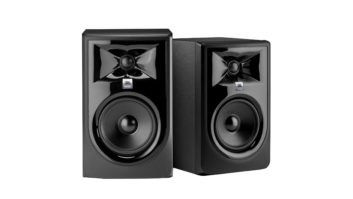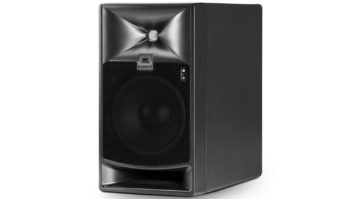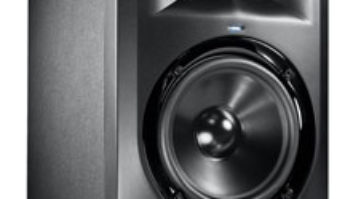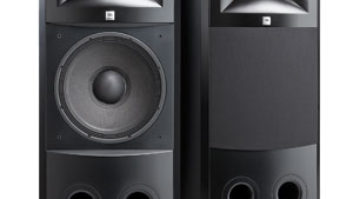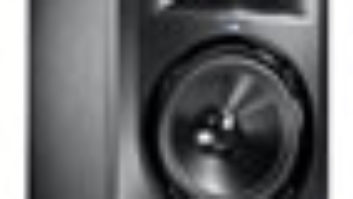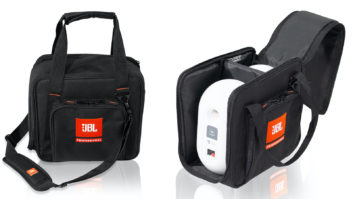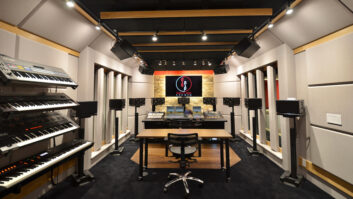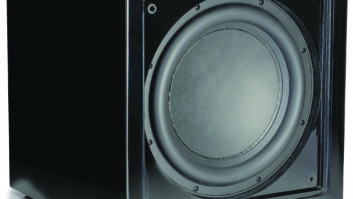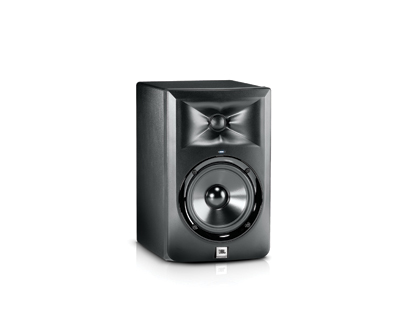
It’s a common, evolutionary development in many industries that cutting-edge technologies introduced in high-end products eventually get incorporated into wares sold at a much lower price. Such is the case with JBL’s acclaimed Image Control Waveguide, which was developed for the company’s flagship M2 Master Reference Monitor. Cradling the tweeter used for the company’s super-affordable LSR305 monitor, the waveguide delivers an extraordinarily wide stereo soundstage, excellent imaging, an unusually broad sweet spot and increased high-frequency detail.
The LSR305 is the smaller of two bi-amplified near-field monitors included in JBL’s 3 Series product line. Reviewed here in a stereo configuration, the two-way monitor features a 5-inch woofer and 1-inch tweeter, measures 11.75×7.28×9.88 inches (HxWxD) and weighs a mere 13.2 pounds.
Art Form
The LSR305’s deep-set Image Control Waveguide looks like the initial stage of someone’s origami project. Four folds transect the waveguide’s horizontal and vertical axes and are most prominent where the waveguide meets the tweeter (see Fig. 1). According to JBL, the waveguide is designed to produce a neutral off-axis frequency response throughout the 305’s entire bandwidth and at the crossover. Additionally, the waveguide optimizes the interface of the tweeter to the listening environment to deliver increased high-frequency detail.
The “LSR” bit in the monitor’s name is shorthand for Linear Spatial Reference, denoting a process in which 72 measurements are taken 360 degrees around the speaker during its design phase to optimize its off-axis response. The monitor’s enclosure and front baffle contribute to reaching that goal: All edges except those at the rear of the enclosure are radiused to thwart diffractive effects that would otherwise mar imaging. The speaker enclosure is constructed of 5/8-inch MDF with a matte-black PVC finish. The injection-molded ABS front baffle—finished with metallic-black acrylic paint—has a slight outward bow that pushes its front face forward most prominently along its vertical midline.
Both the woofer and woven, composite soft-dome tweeter are magnetically shielded. Class-D amplifiers—41 watts each—are used for the drivers and yield 108 dB maximum peak SPL (C-weighted). An indicator lights on the monitor’s front baffle when power is applied. Thermal effects are purportedly minimized, giving the LSR305 the same response at low and high playback levels—an attribute especially important to mix engineers.
The woofer’s dust dome is self-repairing, should your fingers wander too close. The tweeter is damped to reduce distortion at the lower end of its operating range, promising less ear fatigue. The monitor’s 4th-order crossover sits at 1725 Hz.
On the Backside
The monitor’s rear-firing Slip Stream bass port extends the 305’s low-frequency response and is constructed from two segments that are flared differently from one another to reduce air turbulence. The monitor’s frequency response is stated to be 43 Hz to 24 kHz, -10 dB. (An interesting footnote: Peter Chaikin, Senior Manager of JBL’s Recording and Broadcast Marketing division, told me the spec with -10dB tolerance “represents the speaker’s useable LF output because typically, in a room, the LF response is reinforced and can be as much as 10 dB louder than the anechoic measurement.” That explains why, in my reviews of other monitors, I’ve sometimes reported hearing deeper bass extension than what a spec with ±3dB tolerance would imply. That said, not all manufacturers use an anechoic room to measure their monitors’ frequency responses.) Using the more generally accepted ±3dB tolerance, the 305’s frequency response is stated to be 48 Hz to 18 kHz. If you want deeper bass than the 305 provides, the LSR308 extends the low-frequency response to 37 Hz (-10 dB) using an 8-inch woofer. A subwoofer, the LSR310S, drops the -10dB down point to 27 Hz.

Fig. 2: Balanced inputs, two filters, a detented volume control and an input-sensitivity switch grace the LSR305’s rear panel.
Joining the bass port on the 305’s rear panel (see Fig. 2) are balanced (non-latching) XLR and ¼-inch TRS input jacks; the latter can also accept an unbalanced line. A tiny switch selects -10 or +4 dB input sensitivity for respectively accommodating consumer or high-output pro gear; the switch is recessed in a very narrow slot, making it quite difficult to access and adjust, but you’ll likely only have to set it once. Two shelving filters are each adjusted via three-way switches: The LF Trim switch alternately selects +2, 0 or -2 dB boost/cut below 115 Hz, and the HF Trim switch alternately offers the same amounts of boost and cut above 4.4 kHz. An included volume control has numerous detents, allowing repeatable settings.
Finishing off the 305’s rear visage are a power switch and 3-pin IEC power receptacle; the included AC power cord is detachable. The 305’s universal power supply allows plug ’n’ play operation worldwide without having to mess with changing voltage settings. (You’ll still need properly configured AC cables, of course, for your peripatetic studio work.)
Giving a Listen
For my listening tests, I placed two LSR305s in vertical orientation—recommended use—on Primacoustic Recoil Stabilizers (decouplers) situated on console-furniture shelves. The front of my control room features an Acoustic Sciences Corporation Attack Wall, a contiguous arrangement of modular tube traps that tighten up the imaging and impulse response at my mix position. I listened to my own mixes.
Right off the bat, I noticed the 305s produced a startlingly wide soundstage—much wider than that produced by any other stereo pair of monitors I’d ever heard. Hard-panned electric guitars sounded like they were emanating from positions a full foot or more to the left and right of the speakers! (And no, the monitors did not sound at all like this was due to phase problems.) Taken with the 305s’ pinpoint imaging and excellent depth, the sound was delightfully immersive.
The monitors’ sweet spot was also unusually wide, making the LSR305 a compelling choice for mixing on a large-format console. Listening around 30 degrees off-axis, upper-midrange and high frequencies sounded less attenuated than I remember hearing with other monitors at the same position.
With their built-in filters nulled, the 305s sounded smooth and warm, yet very clear. They didn’t suffer tubby reproduction of the upper-bass band and murky-sounding midrange like most other small monitors in its price range do. That said, electric bass guitar sounded quite pillowy (not clearly defined) and its lower-pitched notes relatively weak. Moving the LF Trim switch on each monitor to the +2dB setting helped the bottom end tremendously without penalizing the balance for higher spectra. The bass still sounded a bit pillowy, but I could much more readily identify the fundamental pitch of each note and the instrument’s level sounded way more even across its entire range. JBL evidently chose the LF trim’s corner frequency wisely.
The 305’s excellent transient response and the copious high-frequency detail it produced made drums pop, without sounding hyped. But the monitor’s response must have a subtle dip somewhere in the highs—probably near or at the crossover frequency—as fiddle solos and pick strikes on acoustic guitar sounded very slightly understated. (A frequency-response chart was not provided.) Listening to a mix in which I had slammed a staccato acoustic guitar vamp with an SSL bus compressor to bring it forward, the pippity-pop pick strikes receded slightly into the background of the mix. I don’t want to overstate this, though, because the effect was very subtle.
A Standout Performer
The LSR305 is by far the best-sounding monitor I’ve heard for under $200 to date. In fact, its performance rivals that of many monitors that are several times more expensive. If you’re looking for an inexpensive near-field monitor that handily outperforms its price tag’s promise, this is the one to buy.
Mix contributing editor Michael Cooper is a recording, mix, mastering and post-production engineer and the owner of Michael Cooper Recording in Sisters, Ore.
Try This
If the bass guitar track consistently pops out or dips in level on the same note in your mix, move your head one foot forward or backward and left or right from your mix position. If the level change ceases to occur, ignore it. The problem is a room mode and not in your mix.
Product Summary
COMPANY: JBL
PRODUCT: LSR305
WEBSITE:jblpro.com
PRICE: $399.98/pair list
PROS: Incredibly wide soundstage. Broad sweet spot. Excellent imaging, transient response, midrange clarity and depth. Built-in filters. Very inexpensive.
CONS: Bass sounds a bit pillowy.
